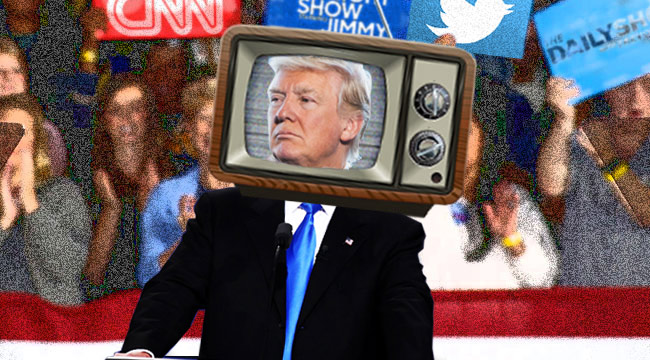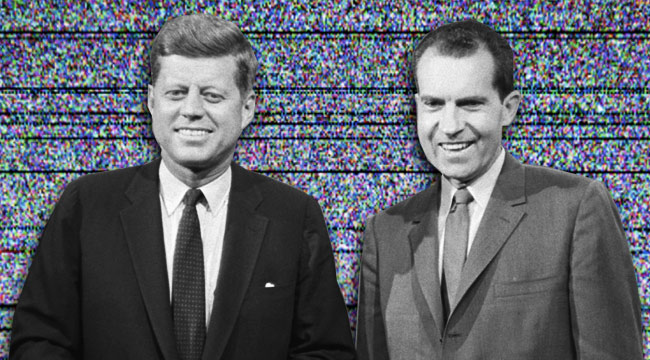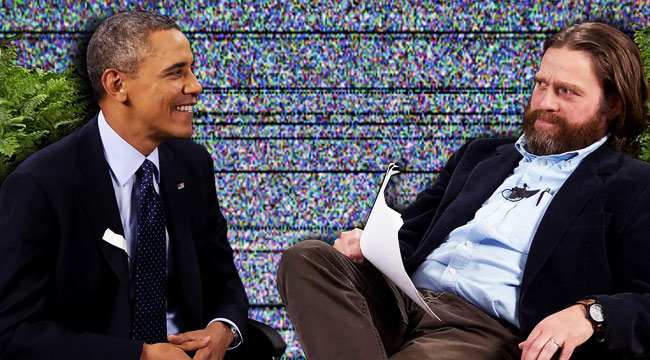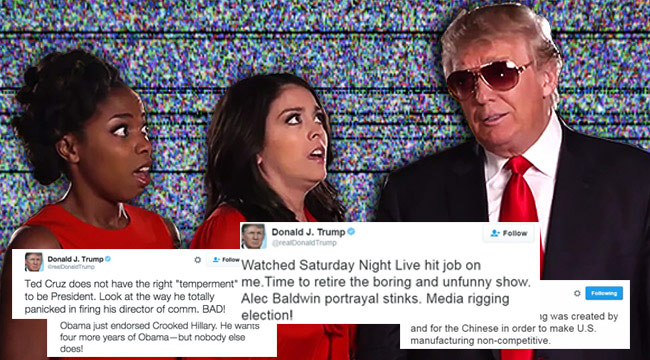
Some hide from new technology, while others worship it as their newfound God. President Lyndon B. Johnson was a retail politician who preferred to practice the art of political seduction through one on one interactions and backroom machinations. Television, with its ability to broadcast a message to the masses and establish a public “brand,” wasn’t for Johnson, but he wasn’t merely indifferent to television and the media; he was hostile toward their incursion into the political process, telling a CBS producer some time after he left office in 1968, “All politics has changed because of you [the media]. You’ve broken all the machines and ties between us in Congress and the city machines. You’ve given us a new kind of people. Teddy [Kennedy], [John] Tunney. They’re your creatures, your puppets.”
Though Johnson lashed out at Teddy Kennedy as a creation of the media, he may have still been holding onto a grudge against the Massachusetts’ Senator’s late brother and Johnson’s running mate, predecessor, and one-time rival, President John F. Kennedy. After a brief and unsuccessful campaign for the nomination at the 1956 Democratic convention, Johnson had felt that it was his turn in 1960 but abstained from officially entering the primaries.
According to The Passage Of Power, by Robert Caro, Johnson believed that voters would admire his decision to continue his important work as Senate Majority Leader and that his allies in Congress could lend him enough support to secure the nomination. But while Johnson regarded then-Senator John F. Kennedy as an insubstantial opponent due to his unremarkable legislative record and his health-related absenteeism in the Senate, he underestimated the growing power of the primaries and Kennedy’s polished public image as a young and telegenic family man. Kennedy became a media darling as he introduced himself to primary state voters in person and by way of TV ads and Johnson, hesitantly, became his Vice President after Kennedy won the nomination on the first ballot at the convention.
Add all that to the media’s role in vividly broadcasting the horrors of war as they were playing out in Vietnam during his Presidency (spurring media criticism that he was particularly sensitive to) and it’s easy to see why Johnson was bitter. But his point, that the spotlight had made likeability a prerequisite for successfully seeking elected office while forcing the messy inner workings of Congress out of the shadows — and away from a place where the ground was fertile for compromise and action — is worth consideration.
In the more than 45 years since Johnson made those remarks, the level of rancor and stagnation in Congress has increased greatly and the sight of a sitting president going on television to read mean tweets in an effort to enhance his likability has become the norm. But while the way leaders communicate and govern has been impacted by the media’s awesome bloom in scope and significance, is this (inevitable and continuing) evolution a bad thing?
With the help of former MTV News reporter Tabitha Soren, Between Two Ferns producer and former Comedy Bang Bang host and creator Scott Aukerman, and University of Arkansas assistant professor of communications Ryan Neville-Shepard, we decided to examine the rise of television and the media’s role in presidential politics (specifically over the last 25 years) to shed some light on that question.
On The Air

The idea of broadly communicating with the electorate through the grace of technology did not spring to life with the popularization of television, of course. With the country quaking from the effects of The Great Depression, President Franklin D. Roosevelt opened up a dialogue with his semi-frequent “Fireside Chats” starting in 1933. While Roosevelt’s efforts were designed to inform and quell fears among listeners, they also effectively humanized him and established a bond between him and voters. In short, it was a tremendous marketing tool for Roosevelt in a time before presidents were an everyday presence in our lives thanks to the media, but the revolution was coming and it was certainly going to be televised.
In 1952, with television on the rise, the campaign of war hero and, eventual president, Dwight D. Eisenhower popularized short TV ads. According to a New York Times article by historian Michael Bechloss, Eisenhower was hesitant to give his approval and both CBS and NBC initially refused to air the ads as they were “beneath the dignity of a possible president.” But the tactic worked and people showed how much they liked “Ike” at the polls. In late September of that year, however, voters weren’t so sure about Eisenhower’s running mate, then-Senator Richard Nixon, who was also about to use television in a revolutionary way by responding to a campaign finance scandal during a thirty-minute special.
The American people are, by and large, more hardened political consumers now than they were in 1952. Nixon’s stand about keeping a dog named Checkers that had been given to his family by a political donor might draw social media mockery now, but at the time it worked to shore up Nixon’s support and keep him in the race. After all, is there anything more relatable or endearing than a parent with a soft spot for his kids?
Despite our world-weary edge, which has been cultivated by embarrassing TV moments like Nixon’s eventual resignation, President Bill Clinton’s impeachment trial, and other televised scandals, voters have always been and seemingly always will be enamored with the dark magic of optics. In the 2016 Presidential debates, demeanor, facial expressions, and handshake frequency mattered as much as the actual issues and those things weighed heavily in the media’s determination of who won those matchups.
In 1960, during the first ever televised Presidential debate, John F. Kennedy scored points for his youthful glow and his effort to look into the camera when answering questions, thus connecting with viewers. Nixon, on the other hand, was visibly sweating and looked at Kennedy when talking.
Nixon’s faith in television was not shaken by the events of the debate, even though the medium may have had a hand in him losing a tight election in 1960. He continued to use the power of the medium to soften his image as his career went on, playing piano on The Jack Paar Show in 1963 and in 1968, shortly before finally becoming President, Nixon popped up on Rowan & Martin’s Laugh-In to utter the phrase, “Sock it to me” in a hollow effort to connect with young voters. Again, a moment such as this feels like blatant (but nonetheless common) pandering now, but its strength was in its novelty at the time.
Looking back at the intersection of politics, television, and the media, it’s clear to see that the definition of what was or wasn’t “beneath the dignity of a possible president” turned relatively slowly from the ’50s to the ’60s and that it continued to do so, bit by bit, for decades. In practice, this undermined evolving social attitudes and the need to fully connect with voters on their terms while acceding to conservative rules of decorum and trying to uphold the notion of the President as some kind of detached King or, in the case of President Ronald Reagan, a well-meaning grandpa.
In 1992, however, things shifted in a dramatic way thanks, in part, to the example set by young and idealistic activists from a generation prior who demanded answers after watching leaders fall, cities burn, and wars rage. The youth vote had untapped power, uncomfortable questions, and high expectations; they just needed the media to make that clear to politicians and for those politicians to be prepared to legitimately value their voice, understand their issues, and govern them as equals. A wink and a nod to youth culture on a talk show wasn’t going to cut it anymore.
Mr. Clinton Goes To MTV

Though Bill Clinton certainly helped to make it clear that politicians are people too with his saxophone solo onThe Arsenio Hall Show, the real difference maker for Clinton came from his willingness to bring the election to young voters as opposed to expecting them to eventually come to him. Though evidence suggested that the youth vote wouldn’t be there in 1992 as it had been in the past, Clinton bet on a rebound and his ability to connect with those voters. He just needed a signal boost.
Known more for airing music videos than for deep, issue-based journalism in the political space, MTV programming chief Judy McGrath made the decision to cover the 1992 Presidential election and launch the Choose Or Lose campaign.
“I believed social issues, politics, and culture were all part of music,” McGrath said in Rob Tannenbaum and Craig Marks’ “I Want My MTV.” McGrath went on to say that she knew the dive into politics would be met with opposition from some viewers, but that she “thought the adults in Washington needed to pay attention” to MTV’s viewers.
As the initial envoy, 24-year-old political reporter Tabitha Soren was sent out onto the campaign trail where she was met with curiosity and slight condescension at the start of the 1992 New Hampshire primary campaign. Soren told Uproxx that the network was also “skeptical at first,” even going so far as to assign her a consultant (current MSNBC analyst and Daily Beast columnist Jonathan Alter) who, unbeknownst to her at the time, was there as a safety net in case she failed. Almost instantly, however, Soren and MTV News’ purpose became clear to the candidates — they were there to ask serious questions about serious issues that mattered to their viewers.
“After I interviewed the people who were running once or chased them down a back hallway — as was the case with Bill Clinton because he was being overshadowed by Gennifer Flowers at that point and was sort of sneaking in and out of his events — they got it,” says Soren. “It was sort of like, ‘Okay, the youth vote.'”
Thrilled by the results and absent their early apprehension, MTV blessed the efforts of Soren, fellow reporter Alison Stewart, MTV News anchor Kurt Loder, and the directors and producers behind the Choose Or Lose effort. Critics were gushing (their efforts garnered them a Peabody Award), politicians were noticing, and older advertisers were coming aboard due to the focus on content that was typically associated with an older audience.
“That made them very keen on it as a corporation,” said Soren, who felt “more and more support,” as Choose Or Lose went from covering the primaries to the conventions, where they used musicians like Megadeath’s Dave Mustaine as correspondents.
Surveying the media landscape now, it’s hard to envision a dearth of youth-focused media options or the novelty of what MTV News was doing in 1992, but they had something of a monopoly with Choose Or Lose and they didn’t bother wasting their newfound access on fluff.
“We, unlike many big news organizations, had the luxury of focusing just on 18 to 24-year-olds,”said Soren. “Certainly, there were younger people who watched MTV, and older people, but for the political stuff, they really decided that we would just narrow the interests to begin with somebody who was [newly] able to vote.” Soren added that the Choose Or Lose coverage was, “very streamlined into the issues that that very narrow demographic was interested in: the environment, abortion rights, [and] college loans.”
While Choose Or Lose focused on heavier topics in an effort to inform young voters and encourage hundreds of thousands of them to register and vote, according to Soren, producers still used quick cuts, pop art graphics, and music to package content.
To truly defy expectations, though,Choose Or Lose needed to remove a barrier and let 18 to 24-year-old voters have a direct audience with the candidates. The Choose Or Lose forum was born, but only Bill Clinton accepted the invitation.
Filmed in June 1992, Choose Or Lose: Facing The Future With Bill Clinton was co-hosted by Soren and CNN’s Catherine Crier and featured questions from voters that ranged from the personal (“How did it feel growing up in an alcoholic family?”) to who he’d pick for the Supreme Court. Set for an hour, the special was extended to 90 minutes and stood out as the high point for both the network’s Choose Or Lose coverage and Clinton’s youth outreach. It may have also helped to win an election with youth turnout that hit a level not seen since 1972. But was this a story of a Clinton victory or a President George H.W. Bush loss?
“While Bush received 53 percent of the votes from those aged 18-29 in 1988, that fell to 34 percent in 1992,” University of Arkansas assistant professor of communications Ryan Neville-Shepard told Uproxx. “Clinton fought hard for the youth vote and succeeded in crafting an attractive personality thanks, in part, to his media appearances.”
Though Bush resisted the forum invitation, calling MTV a “teeny-bopper network” at one point, he did eventually relent.
“It was just a mess because he gave me like ten minutes and he was not very congenial through the whole interview,” said Soren. “He seemed condescending and then as soon as the cameras were off he couldn’t have been nicer and more fun.”
With just days to go before the election, Bush had basically missed his biggest chance to ingratiate himself to a voting block that was eager to hear from him.
“I think it was a mistake to not court young people, however you were going to do it,” said Soren. “I certainly spent a lot of time with young Republicans during that campaign. There was a lot of energy there.”
As President, Clinton worked to keep his ties to the network strong, agreeing to interviews with Soren in the Oval Office and another MTV forum, this time titled, Enough Is Enough, which focused on violence and was co-hosted by Soren and Stewart. MTV would continue the Choose Or Lose campaign up until the 2012 election when it was shuttered. Soren led the 1996 campaign as well and continued working with MTV News, hosting specials like Generation Under The Gun before she left journalism to focus on photography. She recently authored an opinion piece for the New York Times where she expressed concern that, “in trying to interest young people in politics, MTV News inadvertently helped create a model for turning politics into entertainment.”
In 1992, Clinton benefited from what Ryan Neville-Shepard calls the “demassification of media audiences.” Clinton didn’t have to distil his message to young voters when he was on MTV so that he wouldn’t alienate older or more conservative voters — he had a concentrated audience. But now everything is over-segmented and everything said on one show or site can spread to people who have never even heard of those shows or sites, keeping viewers constantly informed at the detriment of context.
As the Nixon approach failed to adapt to a world that demanded more authenticity from its politicians, the Clinton approach couldn’t survive in this media landscape. Now, you’ve gotta be real, and you’ve gotta be entertaining, or you’re gonna be forgotten.
The Infotainer In Chief

“Obama has a certain amount of charisma that we all see that is not really related to the presidency and the job that the president has to do,” says Scott Aukerman, the producer of Between Two Ferns (which has hosted President Obama and also Hillary Clinton) and the host of Comedy Bang Bang. “He just happens to be a very charismatic guy, which serves him well in these types of comedy situations.”
Barack Obama was our most media-conscious president and he was a perfect fit for these times when charisma and an understanding of viral media is currency. The goal remains the same, though: connect with the people, but we’re in an environment where there is a lot of competition for their attention.
In addition to appearing on Between Two Ferns, Obama also made the first presidential appearance on a podcast (Marc Maron’s WTF), and he is the first sitting president to appear on a late night talk show, something he did on numerous occasions. Obama didn’t go on these programs merely to be seen, though. It wasn’t about humanizing himself — if, in 2016, you need to go on a talk show to prove your authenticity and charm, you’ve already lost. We’re past that. When Obama popped up on a show, he had an agenda — fit in, be charming, and sell whatever initiative/idea/candidate you are promoting to the American people as though it were a movie or a TV show. If that meant he had to “Slow Jam The News” on Fallon, read those “Mean Tweets” on Kimmel, or take over Colbert’s desk, then so be it. All the better to have a moment achieve that second life by going viral.
“You’re trying to get your message out there in as many ways as you can, and unfortunately, the younger generation, a lot of times, is not watching the Sunday morning talk shows. They’re not reading The Hill or Politico,” says Aukerman. “They’re wrapped up in their own worlds. They’re wrapped up in college and what they’re doing. What they do do is watch funny videos on the internet, so I think it’s a way to make sure that people see that message.”
In an effort to ensure that that message stays grafted to that ephemeral chunk of pop culture, are we in danger of shows blurring the line between talk show and infomercial, though? According to Aukerman, that’s not the experience that he had in 2014 when he and Zach Galifianakis were invited to The White House to shoot an episode.
“Like anyone coming on the show, they wanted to plug something, which was Obamacare,” Aukerman said. “Other than that, as long as there was a mention of Obamacare… there really were no talking points or no mandates of what we could talk about. There were certain times when some people involved on the staff were a little fearful of it being too comedy-centric, and so I think it’s only five minutes before they mention Obamacare. One person said to me after the shoot, ‘Well that was really funny, but in the edit, we’re probably gonna have to make it mainly about Obamacare, right?’ And we said, ‘No, of course we’re not going to because nothing will turn off a viewer of a video faster than figuring out its an ad.’ We didn’t want it to seem like an ad, we just wanted to make a funny video.”
Aukerman acknowledges that he and Galifianakis went into the process with some “trepidation” because they wondered how much the President’s advisors might try to control the process, but he always had an ace up his sleeve.
“The one thing that we have, that we can use, our only currency is to say, ‘Okay, we don’t do it,’ or ‘We won’t put it out,'” Aukerman said. “I am perfectly willing to do that all the time. With the Obama one, Zach and I talked about, we only wanted to put it out if it was good. The campaign worked with us to make sure that it was a good episode and didn’t feel like it was a sell-out episode, and that’s really what we wanted.”
It’s important to remember that, as Presidents have become commonplace in the late night and web video landscape, the impact of those appearances has waned. Producers, like Aukerman, hold the power in that they can simply bury a segment if the comedic message that they want to convey gets hijacked by a political agenda. But while that check is good for viewers and the media, in general, it births a new concern about the ability of presidents to attach a message to these appearances (or risk regressing to the “Sock It To Me” stage) and it begs the question: what happens when viral videos are no longer enough to get people’s attention?
What’s Next And The Trump Effect

“It’s always interesting to me how long it takes someone to figure out the new thing that they should be doing,” says Aukerman. “What happens usually is someone does Between Two Ferns, it really works, so everyone else calls up and says, I want to do Between Two Ferns, when they should be looking for the next cool thing that’s going to surprise people. At the same time, that’s always kind of changing, and there are constantly going to be new technologies. You saw Obama go on the WTF podcast, which really legitimized podcasting as a new form of getting your message out there, which is really important. There’s going to be new things all the time and presidents are going to want to take advantage of those new ways of getting your message out. Hopefully, they’ll do it sooner rather than later.”
In the 2016 election, we saw the impact of President Obama’s unprecedented media outreach. Hillary Clinton followed him onto Between Two Ferns and, like Vice President Joe Biden before her (Parks And Rec), she made a buzzy appearance on a scripted TV show (Broad City). She also worked hard to align herself with celebrities like LeBron James, Beyonce, Jay-Z, and Bruce Springsteen in an effort to appeal to young voters.
Donald Trump, on the other hand, gave the media thing a shot, hosting Saturday Night Live, but the response was somewhat negative, at least among many fans of the show and critics and the relationship between Trump and the show was matured far beyond caustic ever since.
This shouldn’t come as a surprise, though. According to Ryan Neville-Shepard, conservatives may have a hard time embracing TV and comedy as fully as Barack Obama did.
“There is an undeniable liberal tilt in late night comedy shows,” Neville-Shepard said. “Comedians are human, have their own political preferences, and when successful can have a negative impact on candidate images. Chevy Chase, for instance, has admitted that his portrayal of Gerald Ford came from his political bias, that he wanted to use the show’s huge audience to have some effect on the race, and that other writers from SNL work in the same way. In that sense, many conservatives cannot help but feel that these shows are hostile territory for them.”
So, does that put conservatives at a disadvantage when it comes to reaching the American people? Between Clinton and Obama, there was President George W. Bush, another charismatic leader. But save for the obligatory pre-presidency late night appearances in 2000, Bush mostly resisted the pull of the media. Though, in his defense, the landscape of today is far different than it was in 2008.
Donald Trump understands, better than most, the power of social media, particularly in its ability to reach a mass audience. If you add the likes on Trump’s Facebook page, his Instagram followers, and both his personal Twitter account followers and the count from the POTUS account, his reach is nearly 70 million. Now, some of those followers may be there out of curiosity and not loyalty, and there’s certainly a lot of crossover between the accounts, but Trump still has way more reach than any late night talk show. Additionally, he has the ability to achieve that viral second life via retweets and coverage from both the conservative and mainstream press. For better or worse.
During the election, the trick seemed to be that Trump would charm his people and win new supporters (including disaffected blue-collar voters) by being outrageous and seemingly unfiltered. This while weighing in on the campaign, vaguely asserting his agenda, and deftly distracting from brewing scandals and controversy with misdirection in an effort to tar his opponent, Hillary Clinton.
Following Trump’s surprising victory, many wondered if he would pivot and put aside his personal Twitter account and communicate with the American people through more widely accepted means (there’s that expected presidential decorum again). Trump made it clear in the transition that he wasn’t going to abandon something that had worked for him from the start, however. And faced with a country that didn’t magically heal after an intensely divisive election, a press that holds an interest (and an obligation) in covering the outrage that Trump’s policies and statements have conjured, and the persistent Russian hacking scandal, he has doubled down.
Trump has used Twitter in the early part of his presidency to lash out at other politicians (on ), repeated unsubstantiated claims about election fraud (that supposedly robbed him of a bigger electoral college tally and the popular vote victory), and tried to ensnare others (including President Obama) in the Russian mess. This in addition to tweets against Meryl Streep, Saturday Night Live, and his continuing campaign against the supposedly fake news emanating from CNN, ABC, The New York Times, and others who have put out unfavorable coverage of him.
In continuing to utilize Twitter on a near-daily basis to settle scores, make accusations, and rally his supporters, Trump is proving that no one has ever driven the news cycle as completely as he has and that mass communication through the media (be it TV or the internet) is at its most powerful right now. But this latest evolution has also revealed negative connotations that give credence to the fear that some have had about a possible abuse of the megaphone and the power that comes with it.
Donald Trump’s ever-present place on our screens and at our dinner tables is unlike anything we’ve ever seen before. Whereas past presidents have used the mass media to break through the noise, it could be argued that Trump is the noise. And while it has been effective for him, there has been an impact on the weight we assign to facts and in the faith people have in our intelligence community, the free press, and in our government thanks to Trump’s seeming expectation that an election win result in fielty from the opposition, the press, and his supporters.
And that’s to say nothing of the universal need to live a life that is occasionally free from the daily squabbles and horrifying realities of politics and governing. Which is, you know, why we hire politicians in the first place.
So, is this marriage between mass media communication and the presidency bad? Right now, let’s grade it as an incomplete because, really, so much hinges on what comes next. The glow of the TV, the smartphone, and the laptop can unite us sure as it can divide us. The choice is ultimately ours when it comes to what we choose to give power to. Because what good is a megaphone if people walk away from the speaker?
This is an updated version of a post that ran on November 8, 2016. It has been amended to reflect the early part of Donald Trump’s term as president.
